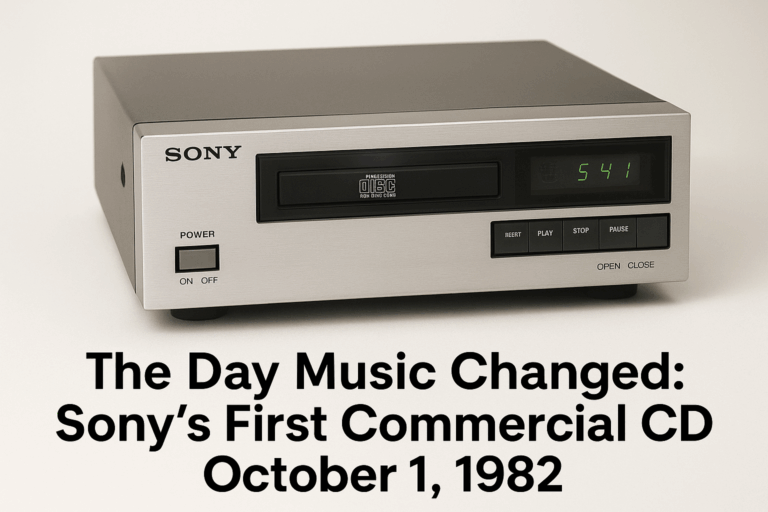On October 1, 1982, Sony quietly unleashed a technological revolution that would reshape music forever: the first commercial compact disc (CD) was released in Tokyo. This wasn’t just a new way to listen to music—it was the start of the digital music era, a cultural and technological shift that would touch every home, studio, and record store in the world.
Before CDs, music was limited to vinyl records and cassette tapes, both analog formats prone to wear, scratches, and distortion over time. Vinyl scratches, cassette tapes stretched, and every play slightly degraded the sound. Sony’s CD introduced a digital alternative, offering near-perfect audio reproduction that didn’t degrade, giving music lovers a new way to experience sound.
The First CD: A Historic Release
The first CD ever released commercially was Billy Joel’s “52nd Street”, paired with a brand-new Sony CD player. Why Billy Joel? He was already a global superstar, with multiple platinum albums, and his music showcased the crystal-clear, dynamic sound that CDs could deliver. Suddenly, listeners could hear every subtle note, every precise drumbeat, and every piano flourish exactly as the artist intended—something analog formats could never guarantee.
How CDs Changed Listening Forever
Before CDs, music came on vinyl records and cassette tapes, which were fragile and degraded over time. Scratched vinyl skipped, cassette tapes stretched and hissed, and repeated play slowly wore away the quality. The CD solved all of this:
Digital Perfection: Music stored in binary code meant no degradation over time.
Durability: Played hundreds of times without any loss of quality.
Portability & Storage: Compact, light, and easy to store—far smaller than bulky vinyl.
Instant Access: Track skipping and fast-forwarding became easier than ever before.
The CD Boom of the 1980s and 1990s
Once Sony released the first CD, the world took notice. Record companies raced to reissue classic albums in the new format, and music lovers began upgrading their collections. By the mid-1980s, CD sales were skyrocketing:
1983–1985: Early adopters bought high-end players; CDs became status symbols.
Late 1980s: Major labels fully embraced CDs, reissuing entire catalogs.
1990s: CDs dominated music sales globally, reaching their peak around 1997–1998.
This was the golden era of the compact disc. Artists and bands thrived: albums sold in unprecedented numbers, global distribution was easier, and fans could finally own perfect-sounding recordings. Pop, rock, jazz, classical, and hip-hop all benefited from the CD revolution.
Cultural Impact
The CD wasn’t just a tech upgrade—it changed how people experienced music:
Album art became smaller but more impactful.
DJs and producers could manipulate digital tracks with new precision.
Collectors valued limited editions and special releases.
Home audio systems upgraded to match the CD’s high-fidelity sound.
The compact disc also symbolized the rise of Japanese electronics and global tech innovation. Sony became synonymous with cutting-edge technology and quality.
The Decline and Legacy of the CD
By the early 2000s, the CD’s dominance began to fade. MP3s, digital downloads, and streaming services offered instant access to music without physical discs. Big-box retailers gradually removed CDs from shelves, and consumers embraced the convenience of digital libraries.
Despite this decline, the CD’s legacy is immense:
It bridged analog and digital music.
It established global music distribution networks.
It shaped modern streaming culture.
It influenced how albums are produced, mastered, and marketed.
In short, without the CD, there might not be Spotify, Apple Music, or Amazon Music today. The release on October 1, 1982 was more than a product launch—it was a turning point in music, technology, and culture.
Closing Thoughts
The compact disc may no longer dominate our shelves, but its impact echoes through every digital file we play today. It stands as a monument to innovation, quality, and the relentless drive to improve how the world experiences music. Sony’s first CD wasn’t just a disc—it was a declaration that music would never be the same again.
#ShauneeNation #MusicHistory #SonyCD #DigitalMusic #BillyJoel #1982Music #TrailHeadTales #CDRevolution #MusicTech #DigitalEra


